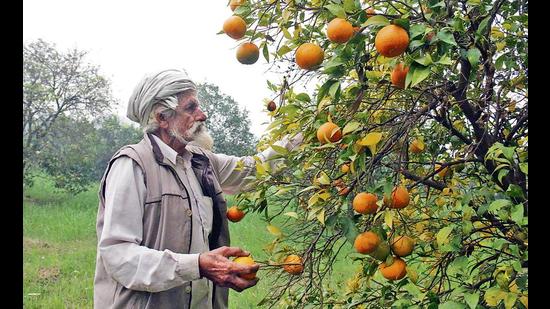Punjab kinnow growers worried as production likely to dip by 60%
Kinnow growers in Punjab are apprehending losses this year as the production is likely to go down with 60% decline in plant flowering
Kinnow growers in Punjab are apprehending losses this year as the production is likely to go down with 60% decline in plant flowering.

The state witnessed bumper crops in the last two seasons. An estimated 8 lakh metric tonne kinnow was produced in the state in 2020-21, it is learnt.
Punjab leads the country in the cultivation of kinnow, with Fazilka district’s Abohar belt alone contributing up to 60% to the state’s total production. The fruit is cultivated on over 37,000 hectares in Punjab with a concentration in Fazilka and pockets of Muktsar, Bathinda and Hoshiarpur districts.
HS Rattanpal, principal horticulturist, Punjab Agriculture University (PAU), said alternate bearing is common but this time inclement weather hit orchards at the flowering stage.
Pardeep Dawra, a leading kinnow grower from Gidderanwali near Abohar, said the state would witness such a sharp decline in kinnow production after 18-20 years.
“The last two seasons were encouraging when Punjab saw bumper crops. It is common that fruit yield drops after 1 or 2 bumper crop seasons, but this is exceptionally worrying. Climatic conditions in March were non-conducive for trees at flowering stage,” said Dawra.
Balwinder Tikka, a progressive farmer from Muktsar’s Abul Khurana village, said more than 30% of his 100-acre orchard had no flowering at all while a sizeable area recorded less flowering in the rest of the farm.
Tikka said most kinnow farmers would face losses as even higher rates in the coming season may not be able to compensate them for the drop in production.
“At the flowering stage, a kinnow tree needs temperature between 25 and 30 degrees Celsius. But this year, the flowering window period in February and March was warmer, leading to a decrease in flowering. When fruit sets in the rest of the crop, storms in March and April caused fruit shedding,” he added.
The kinnow rates are mainly determined by the production of the orange crop.
Kinnow trader and grower Surinder Charaya said despite a fall in production, farmers may expect higher prices for their produce. “Kinnow has a major market in the states of Karnataka, Tamil Nadu, Telangana and Gujarat. Market rates of kinnow may escalate significantly than the 2020-21 season’s average ₹9 per kg at farm gate if its availability remains limited. It is a wait-and-watch situation as most will depend upon the orange crop yield in Maharashtra’s Nagpur belt,” he added.



